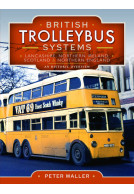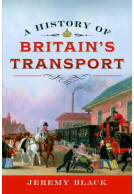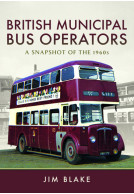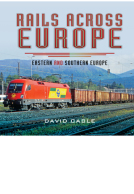Regional Tramways - Scotland (Hardback)
Imprint: Pen & Sword Transport
Pages: 144
Illustrations: 200
ISBN: 9781473823853
Published: 11th April 2016
(click here for international delivery rates)
Order within the next 9 hours, 14 minutes to get your order processed the next working day!
Need a currency converter? Check XE.com for live rates
| Other formats available - Buy the Hardback and get the eBook for free! | Price |
|---|---|
| Regional Tramways - Scotland ePub (13.0 MB) Add to Basket | £10.00 |
This is the first of a new series of books that will cover the history of tramway operation in the British Isles.
Focusing on Scotland, this book provides an overview of the history of tramways north of the border from the 1940s, when the first horse-drawn service linking Inchture village to Inchture station opened, through to the closure of the last traditional tramway – Glasgow – in 1962.
Concentrating on the big city systems that survived the Second World War – Aberdeen, Dundee, Edinburgh and Glasgow – the book provides a comprehensive narrative, detailing the history of these operations from 1945 onwards, with full fleet lists, maps and details of route openings and closures.
The story is supported by some 200 illustrations, both colour and black and white, many of which have never been published before, that portray the trams that operated in these cities and the routes on which they operated. Bringing the story up-to-date, the book also examines the only second-generation tramway yet to be built in Scotland – the controversial system recently constructed in Edinburgh – as well as informing readers where it is still possible to see Scotland’s surviving first-generation trams in preservation.
As an overview of the region's tramways this is an excellent book.
Stephenson Locomotive Society
Recommendable if your interest is trams and their social interaction with associated communities.
Illustrated by many fine images, in Regional Tramways, Scotland, Peter Waller dips successfully into the social history north of the border during the first half of the 20th century, when trams were the urban transport kings.
Evergreen, Autumn 2016
For those who knew the trams or those interested in their history, this excellent publication is well worth acquiring.
Friends of the West Highland Lines
Books that have been read by book reviewers can sometimes have a rather dog-eared "second hand" feel to them. As you read through the book, the temptation to fold over the corners of pages to allow you to find some point or passage you wish to refer back to can be overwhelming. But just occasionally you find yourself handling a book that has been so beautifully produced and of such obvious enduring value that it would simply feel wrong to mark it in any way.
Undiscovered Scotland
When we read "Regional Tramways, Scotland" by Peter Waller it was to the accompaniment of assorted scraps of paper that could be inserted into the book as non-destructive placeholders. This really is an outstanding book. Large format and, as already implied, beautifully produced, it comes with a truly outstanding collection of large photographs, many taken, as the author notes in his introduction, by his late father, Michael H. Waller.
With the exception of a single preserved line in an industrial museum in central Scotland, and the more recent reintroduction of trams in Edinburgh, trams largely went out of use in Scotland's cities during the 1950s, with the last disappearing from the streets of Glasgow in 1962. To leaf through the pages of this book is therefore to take a journey back in time, to an era that can now be remembered by a diminishing number of people. To see that era brought to life in such a vivid and immediate way is a real joy.
But this is far more than just a picture book, however good its illustrations. It is also a superbly researched history of trams in Scotland. The book begins with an overview of the story of trams across the country from the 1840s onwards. We then move on to chapters looking in considerable detail at the stories of trams in Aberdeen, Dundee, Edinburgh and Glasgow between the end of World War Two and their demise in each city. In each case the route networks are described and mapped, and the different types of vehicles discussed. And in each case the inevitable path of decline and closure is charted, showing clearly the reasons why trams were viewed at the time as fit only for replacement by buses. Edinburgh's modern trams are briefly covered, and there's a nice section at the end on the (limited) preservation of Scottish trams. Definitely a book we'll be referring to time and again, and one we're very happy to have left unmarked!
An overview of the history of Scotland's trams from the 1940's, when the first horse-drawn service linking Inchture village to Inchture station opened, through to the closure of the last traditional tramway in 1962. The book includes more than 200 illustrations, many of which have never been published before.
History Scotland/May 2016
The author, Peter Waller, is a director and secretary of the Online Transport Archive and that is the source of the majority of the pictures. The books are best considered as falling into the “photo collections with captions” type rather than detailed tramway histories, although they are certainly more than just picture books.
Tramfare Magazine
The Scotland book includes many original photos by the author’s father, Michael H. Waller. There are chapters on Aberdeen, Dundee, Edinburgh and Glasgow, plus a couple of pages on the new Edinburgh tramway. Glasgow, as you would expect being such a big system, gets nearly fifty pages.
At twenty-five pounds for a hardback book they are certainly value for money. These are good books, which I can thoroughly recommend and I keenly look forward to the future volumes.
About Peter Waller
Brought up in Bradford, PETER WALLER grew up as the city’s trolleybus network gradually declined. In 1986 he commenced a career in publishing working for a number of years as Ian Allan Ltd publishing books, where he oversaw the commissioning and publication of a wide range of books. The first book he wrote was British and Irish Tramway Systems since 1945, in 1992. Since then he has written a number of transport books, moving to Shropshire where he is a director and secretary of the Online Transport Archive, vice-chairman of the West Shropshire Talking Newspaper, a committee member of the National Railway Heritage Awards and a past president of Rotary Club of Shrewsbury. He became a Council member of the National Transport Trust in 2020.




















